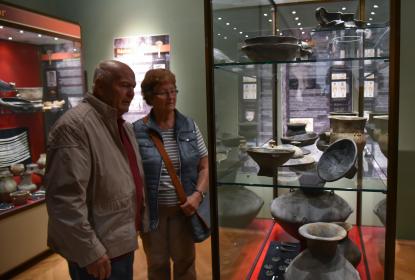2025. April 4. Friday
István Dobó Museum - Eger
|
|
Address: 3300, Eger Vár 1.
Phone number: (36) 312-744
E-mail: varmuzeum@egrivar.hu
Opening hours: Castle: Mon-Sun 9-19
Exhibitions: Mon-Sun 10-16 Panopticon: Mon-Sun 10-16 |
Museum tickets, service costs:
|
Individual combined ticket for adults
(István Dobó Museum + Géza Gárdonyi Memorial Museum + Sándor Ziffer Gallery + Lenkey House)
|
4800 HUF
|
|
|
Individual combined ticket for students
(István Dobó Museum + Géza Gárdonyi Memorial Museum + Sándor Ziffer Gallery + Lenkey House)
|
2800 HUF
|
|
|
Individual combined ticket for pensioners
(István Dobó Museum + Géza Gárdonyi Memorial Museum + Sándor Ziffer Gallery + Lenkey House)
|
2800 HUF
|
|
|
Individual walk ticket for adults
|
2400 HUF
|
|
|
Individual walk ticket for students
|
1200 HUF
|
|
|
Individual walk ticket for pensioners
|
1200 HUF
|
|
|
Group guide
|
15000 HUF
|
/ group
|
|
Group guide
|
20000 HUF
|
/ group
|
|
Individual wedding photographs
|
15000 HUF
|
The exhibition presents archeological findings from the territory of Heves County, from the Stone Age to the era of the Hungarian conquest of the Carpathian Basin.

The exhibition provides an insight into the work of archeologists and restorers from the beginning of the collection to the results of the latest research, as they attempt to put together pieces of our history from the objects and phenomena discovered.
They bring the memories of the past to life through reconstruction devices, copies and short films about the work of archeologists and the results of experimental archeology. Very little is taught in schools about this era encompassing several millennia, so through the guided exhibition tours, museum classes and museum educational courses those who are interested can become acquainted through the objects on display with the history of the eras preceding the foundation of the Hungarian Kingdom and the everyday lives of the people who lived here.

The exhibition provides an insight into the work of archeologists and restorers from the beginning of the collection to the results of the latest research, as they attempt to put together pieces of our history from the objects and phenomena discovered.
They bring the memories of the past to life through reconstruction devices, copies and short films about the work of archeologists and the results of experimental archeology. Very little is taught in schools about this era encompassing several millennia, so through the guided exhibition tours, museum classes and museum educational courses those who are interested can become acquainted through the objects on display with the history of the eras preceding the foundation of the Hungarian Kingdom and the everyday lives of the people who lived here.
